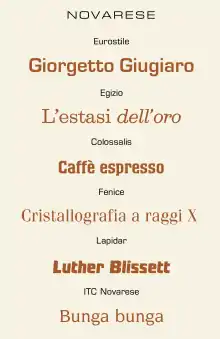Aldo Novarese
Aldo Novarese (29 June 1920 – 16 September 1995) was an Italian type designer who lived and worked mostly in Turin.
Aldo Novarese | |
|---|---|
| Born | June 29, 1920 |
| Died | September 16, 1995 (aged 75) |
| Nationality | Italian |
| Known for | typography |
Notable work | Microgramma, Eurostile |
| Awards | Compasso d'Oro |
Training and career
After learning woodcutting, copper engraving, and lithography at the Scuola Arteri Stampatori in Turin, Novarese worked as a draftsman at the Nebiolo type foundry. He became art director there in 1952. He taught at the Scuola Vigliardi Paravia for ten years beginning in 1948. By 1977, foundry type had become largely obsolete, and Novarese left Nebiolo to become a freelance designer. [1]
Fonts designed by Aldo Novarese

Novarese designed a wide range of typefaces. His most famous design is probably Eurostile, a geometric sans-serif design. It utilized shapes based on subtly curved rectangles with rounded corners, reflecting the modern designs that were gaining popularity at the time, influenced by the subtly curved shape of a cathode ray tube screen or airplane windows. It became very popular as a typeface that evokes technology (it can be seen on the speedometers on many cars and vehicles, particularly older models). This was an expansion and development of the earlier design Microgramma typeface (designed in a project led by Alessandro Butti), an all-caps design.
Foundry Type for Nebiolo
- Landi Linear (1939-43), variations on "Welt."
- Athenaeum (1945) with Alessandro Butti; calligraphy-influenced old-style serif font.[2]
- Normandia (1946-49) with Alessandro Butti.
- Augustea (1951) with Alessandro Butti.
- Microgramma (1951) with Alessandro Butti.
- Cigno (1954)
- Fontanesi (1954)
- Egizio (1955-58), a Clarendon design with an italic.[3]
- Juliet (1955)
- Ritmo (1955)
- Garaldus (1956-60)
- Slogan (1957)
- Recta (1958-61)
- Estro (1961)
- Eurostile (1962), basically Microgramma with a lower case.
- Magister (1966)
- Oscar (1966)
- Forma (1966-7); supervised by a larger design team. Neo-grotesque sans influenced by Helvetica.[4][5][6][7]
- Metropol (1967)
- Elite (1968)
- Stop (1970), futuristic display font.[8]
Photo-Type
- Delta (1968)
- Dattilo (1974)
- Lapidar (1977)
- Fenice (1977-80), Didone serif font oriented to display use with an oblique rather than an italic.[9]
- Novarese (1978), wedge-serif font with a nearly upright italic.[10]
- Floreal (1980)
- Mixage (1980), humanist sans-serif.[11]
- Symbol (1982)
- Expert (1983)
- Colossal (1984)
- ITC Symbol (ITC, 1984), an almost sans-serif face with flaring at the ends, slightly similar to Optima or wedge-serif faces.[12] Not a symbol font.
- ITC Mixage (ITC, 1985)
- Arbiter (1989)
References
- Jaspert, W. Pincus, W. Turner Berry and A.F. Johnson. The Encyclopedia of Type Faces. Blandford Press Lts.: 1953, 1983. ISBN 0-7137-1347-X.
- Friedl, Ott, and Stein, Typography: an Encyclopedic Survey of Type Design and Techniques Throughout History. Black Dog & Levinthal Publishers: 1998. ISBN 1-57912-023-7.
- Font Designer - Aldo Novarese
- Novarese, Aldo - A French website about Aldo Novarese
- tipografia: Aldo Novarese (1920-95)
- Identifont: Aldo Novarese (1920-1995)
- Friedl, Ott, and Stein, p. 404.
- "Athenaeum". Linotype. Retrieved 3 July 2016.
- "Egizio LT". Linotype. Retrieved 3 July 2016.
- Kupferschmid, Indra. "Finding Forma". Font Bureau. Retrieved 20 March 2016.
- Colizzi, Alessandro. "Forma, Dattilo, Modulo: Nebiolo's last efforts to produce a universal typeface". academia.edu. Retrieved 20 March 2016.
- Colizzi, Alessandro. "Forma, Dattilo, Modulo. Nebiolo's last effort to produce a 'universal' typeface". ATypI conference 2013. Retrieved 20 March 2016.
- Miklavčič, Mitja. "Forma: a typeface designed by a committee". Mitja-M. Archived from the original on August 22, 2011. Retrieved 20 March 2016.
- "Stop". Linotype. Retrieved 3 July 2016.
- "ITC Fenice". Linotype. Retrieved 3 July 2016.
- "ITC Novarese". Linotype. Archived from the original on 1 August 2016. Retrieved 3 July 2016.
- "ITC Mixage". Linotype. Retrieved 3 July 2016.
- "ITC Symbol". Linotype. Archived from the original on 1 August 2016. Retrieved 3 July 2016.
